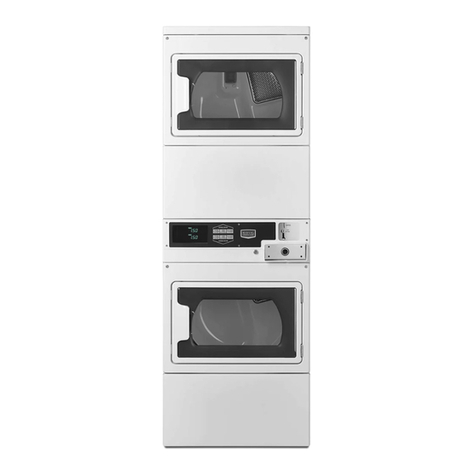
5
DRYER SAFETY
ʼnDo not install or store the dryer where it will be exposed to
the weather.
ʼnDo not tamper with controls.
ʼnClean dryer lint screen before or after each load.
ʼnDo not use this dryer without the lint screen in place.
ʼnDo not repair or replace any part of the dryer or attempt
any servicing unless specically recommended in this Use
and Care Guide or in published user-repair instructions
that you understand and have the skills to carry out.
ʼnFabric softeners, or similar products, should be used as
specied by the fabric softener instructions.
ʼnItems such as foam rubber (latex foam), shower caps,
waterproof textiles, rubber-backed articles, and clothes or
pillows tted with foam rubber pads should not be dried in
the tumble dryer.
ʼnThe nal part of a tumble dryer cycle occurs without
heat (cool-down cycle) to ensure that the articles are left
at a temperature that ensures that the items will not be
damaged.
ʼnWARNING: Never stop a tumble dryer before the end of
the drying cycle unless all items are quickly removed and
spread out so that the heat is dissipated. (Avoids risk of
spontaneous combustion).
ʼnWARNING: The appliance must not be supplied
through an external switching device, such as a timer, or
connected to a circuit that is regularly switched on and off
by a utility.
ʼnIn case of electrical supply failure, remove the load
quickly and spread it out to avoid risk of spontaneous
combustion.
ʼnKeep area around the exhaust opening and adjacent
surrounding areas free from the accumulation of lint, dust,
and dirt.
ʼnVentilation openings in the base shall not be obstructed by
a carpet or similar object.
ʼnThis appliance is intended, but not limited, to be used in
public areas.
ʼnThis dryer is not intended for use by persons (including
children aged from 8years and above) with reduced
physical, sensory, or mental capabilities, or lack of
experience or knowledge, unless they have been given
supervision or instruction concerning use of the dryer by a
person responsible for their safety.
ʼnBefore the dryer is removed from service or discarded,
remove the door to the dryer compartment.
IMPORTANT SAFETY INSTRUCTIONS
WARNING: To reduce the risk of re, electric shock, or injury to persons when using the dryer, follow basic precautions, including
the following:
SAVE THESE INSTRUCTIONS
ʼnRead all instructions before using the dryer.
ʼnThis dryer is intended only for drying clothes and textiles
that have been washed in water. Do not use for any other
purpose.
ʼnWARNING: If you smell gas, do not use the dryer or any
electrical equipment nearby. Warn other people to clear
the area. Contact the dryer owner immediately.
ʼnOil-affected items can ignite spontaneously, especially
when exposed to heat sources such as a tumble dryer.
The items become warm, causing an oxidation reaction
in the oil. Oxidation creates heat. If the heat cannot
escape, the items can become hot enough to catch re.
Piling, stacking or storing oil-affected items can prevent
heat from escaping and so create a re hazard.
ʼnIf it is unavoidable that fabrics that contain vegetable or
cooking oil or that have been contaminated by hair care
products be placed in a tumble dryer, they should rst
be washed in hot water with extra detergent – this will
reduce, but not eliminate the hazard.
ʼnDo not dry articles that have been previously cleaned in,
washed in, soaked in, or spotted with petrol, dry-cleaning
solvents, other ammable, or explosive substances as
they give off vapors that could ignite or explode.
ʼnItems that have been soiled with substances such as
acetone, alcohol, petrol, kerosene, spot removers,
turpentine, waxes, and wax removers should be washed
in hot water with extra detergent before being dried in the
dryer.
ʼnDo not dry unwashed items in the dryer.
ʼnDo not use this dryer if industrial chemicals have been
used for cleaning. The possible presence of residual
quantities of aggressive or decomposed chemicals in
the load may produce damage to the dryer and harmful
fumes.
ʼnDo not allow children to play on or in the dryer. Close
supervision of children is necessary when the dryer is
used near children. Cleaning and user maintenance
shall not be made by children without supervision.
Children of less than 3 years should be kept away unless
continuously supervised.
ʼnIf drum rotation is blocked due to trapped textiles,
disconnect the dryer from the electrical supply before
gently removing the blockage.
ʼnIf the dryer is not heating, or appears to be defective or
damaged, do not use it. Contact the owner.






































